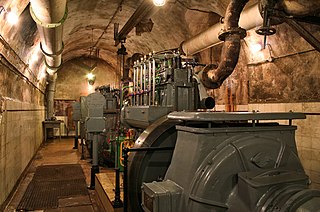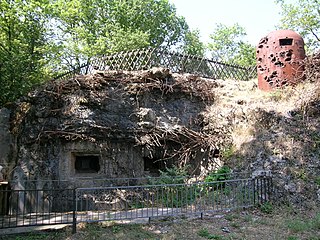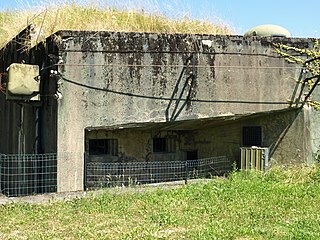
The Maginot Line, named after the French Minister of War André Maginot, is a line of concrete fortifications, obstacles and weapon installations built by France in the 1930s to deter invasion by Germany and force them to move around the fortifications. The Maginot Line was impervious to most forms of attack. In consequence, the Germans invaded through the Low Countries in 1940, passing it to the north. The line, which was supposed to be fully extended further towards the west to avoid such an occurrence, was finally scaled back in response to demands from Belgium. Indeed, Belgium feared it would be sacrificed in the event of another German invasion. The line has since become a metaphor for expensive efforts that offer a false sense of security.

The Alpine Line or Little Maginot Line was the component of the Maginot Line that defended the southeastern portion of France. In contrast to the main line in the northeastern portion of France, the Alpine Line traversed a mountainous region of the Maritime Alps, the Cottian Alps and the Graian Alps, with relatively few passes suitable for invading armies. Access was difficult for construction and for the Alpine Line garrisons. Consequently, fortifications were smaller in scale than the fortifications of the main Line. The Alpine Line mounted few anti-tank weapons, since the terrain was mostly unsuitable for the use of tanks. Ouvrage Rimplas was the first Maginot fortification to be completed on any portion of the Maginot Line, in 1928. The Alpine Line was unsuccessfully attacked by Italian forces during the Italian invasion of France in 1940. Following World War II, some of the larger positions of the Alpine Line were retained in use through the Cold War.

Ouvrage Michelsberg, one of the Maginot Line fortifications, formed part of the Fortified Sector of Boulay as well as the fortified region of Metz. The ouvrage is located in Moselle (département) between the towns of Dalstein and d'Ebersviller, about 23 km from Thionville. It is located between gros ouvrage Mont des Welches and petit ouvrage Hobling, facing Germany. Michelsberg did not see significant action in the Battle of France until June 1940, when it was attacked from the rear by German forces that had bypassed the Maginot Line. It successfully resisted these attacks, but was compelled to surrender in accordance with the 25 June 1940 armistice. After the Second World War it was renovated as a Cold War fortification against a potential Soviet invasion, then abandoned. It is now operated as a museum, and may be visited.
Ouvrage Coume Annexe Nord is a lesser work of the Maginot Line. Located in the Fortified Sector of Boulay, the ouvrage consists of one infantry block, and is located between petits ouvrages Village Coume and Coume, facing Germany.

Ouvrage Bambesch is a lesser work of the Maginot Line. Located in the Fortified Sector of Faulquemont, the ouvrage consists of three infantry blocks, and is located between petits ouvrages Kerfent and Einseling, facing Germany. Completed in 1932, it is located in the Bois de Bambesch. On 20 June 1940 during the Battle of France, Bambesch was attacked by German forces, whose artillery battered the position, which could not be effectively supported by its neighbors, into surrender. Since 1973, Bambesch has been operated as a museum and is open to the public.

Ouvrage Sentzich is part of the Fortified Sector of Thionville of the Maginot Line. The petit ouvrage for infantry is located to the south of gros ouvrage Galgenberg, on the edge of the main road to Luxembourg near the village of Sentzich. Gros ouvrage Métrich is to the east. As a small work, it was not considered for use after World War II and was abandoned. It is secured, but is not open to the public.

Ouvrage Oberheid, also called Ouvrage Oberheide, forms a portion of the Fortified Sector of Thionville of the Maginot Line in northeast France. The petit ouvrage d'infanterie is located on a salient point of the Cattenom Forest between the gros ouvrages Kobenbusch and Galgenberg, which provided covering fire during June 1940, when Oberheid faced daily bombardments and infiltrations. Oberheid has been abandoned and after extensive vandalism has been sealed.

Ouvrage Otterbiel forms part of the Maginot Line in the Fortified Sector of Rohrbach, Sub-sector of Bitche, and is located on the Camp de Bitche of the French Army. It is located between gros ouvrage Schiesseck and petit ouvrage Grand Hohekirkel. Part of the Fortified Sector of Rohrbach, the petit ouvrage comprises four combat blocks and an entry block. Due to budget restrictions, a planned flanking infantry block was never constructed. Otterbiel saw no significant action in the Battle of France, and limited action during the 1944/45 Lorraine Campaign. It was renovated for use during the Cold War. Otterbiel is used for ammunition storage by the French Army.

Ouvrage Rohrbach is a petit ouvrage of the Maginot Line located in the community of Bettvillier, near Rohrbach-lès-Bitche in the Moselle département, facing Germany. The Fortified Sector of Rohrbach was built somewhat later than its neighbors to the east and west, and in company with positions on the extreme western end of the Maginot Line, became one of the "New Fronts."

Ouvrage Simserhof is a gros ouvrage of the Maginot Line, located in the French commune of Siersthal in the Moselle department. It faces the German border and is adjoined by the petit ouvrage Rohrbach and the gros ouvrage Schiesseck. Located 4 km west of Bitche, the ouvrage derived its name from a nearby farm. It was part of the Fortified Sector of Rohrbach. During the Battle of France in 1940, the Simserhof supported its neighboring fortifications with partially successful covering artillery fire. After the surrender of France, it was repurposed by the Germans as a torpedo storage depot, and later resisted the American advances of late 1944. The Americans briefly occupied the fort in the first days of 1945 until the German counter-offensive of Operation Nordwind, which allowed them to take back control of the Simserhof. The fort was finally liberated by the 100th Infantry Division on March 15, 1945. Following the war, it was initially repaired for the French Army and later converted into a Maginot Line museum in the early 1960s. Retained by the Ministry of Defense, Simserhof now functions as a museum, and has the most extensive visitor infrastructure of any of the preserved Maginot fortifications.
Ouvrage Grand-Hohékirkel is a petit ouvrage of the Maginot Line, located near Bitche in the French département of Moselle. Grand-Hohékirkel is adjoined by gros ouvrage Otterbiel to the west and petit ouvrage Lembach at some distance to the east, and faces the German frontier. It was part of the Fortified Sector of the Vosges.
Ouvrage Eth is an isolated petit ouvrage of the Maginot Line, built as part of the "New Fronts" program to address shortcomings in the Line's coverage of the border with Belgium. It is located between the villages of Eth and Wargnies-le-Grand, in Nord département. Eth is the sole Maginot fortification in the Fortified Sector of the Escaut, which primarily consisted of individual casemates, blockhouses and the improved 19th-century Fort de Maulde. During the Battle of France the ouvrage resisted artillery attack for four days before the garrison evacuated through a drain to a neighboring casemate.
Ouvrage Les Sarts is a petit ouvrage of the Maginot Line, built as part of the "New Fronts" program to address shortcomings in the Line's coverage of the border with Belgium. Like the other three ouvrages near Maubeuge, it is built on an old Séré de Rivières system fortification, near the town of Marieux.

Ouvrage Boussois is a petit ouvrage of the Maginot Line, built as part of the "New Fronts" program to address shortcomings in the Line's coverage of the border with Belgium. Like the other three ouvrages near Maubeuge, it is built on an old Séré de Rivières fortification, near the town of Boussois. The fortification surrendered to the Germans twice, in the First World War on 6 September 1914, and in the Second World War on 22 May 1940. The site is now abandoned.

Ouvrage La Salmagne is a petit ouvrage of the Maginot Line, built as part of the "New Fronts" program to address shortcomings in the Line's coverage of the border with Belgium. Like the other three ouvrages near Maubeuge, it is built on an old Séré de Rivières system fortification, near the town of Bersillies. The Ouvrage Bersillies is nearby to the northwest. La Salmagne has been preserved and is open to the public.
Ouvrage Bersillies is a petit ouvrage of the Maginot Line, built as part of the "New Fronts" program to address shortcomings in the Line's coverage of the border with Belgium. Like the other three ouvrages near Maubeuge, it is built on an old Séré de Rivières-system fortification, near the town of Bersillies. The preserved Ouvrage La Salmagne is nearby to the southeast. Bersillies is not open to the public.
Ouvrage Barbonnet is a work of the Maginot Line's Alpine extension, the Alpine Line, also called the Little Maginot Line. The ouvrage consists of one entry block and one infantry block facing Italy. The ouvrage was built somewhat behind the main line of fortifications on the old Fort Suchet, which was already armed with two obsolete Mougin 155mm gun turrets.

Ouvrage Chesnois, also known as Ouvrage Chênois, is a gros ouvrage of the Maginot Line, located in the Fortified Sector of Montmédy, facing Belgium. The ouvrage lies between the towns of Montlibert and Thonne-le-Thil. It possesses six combat blocks. It is located between gros ouvrage Thonnelle and petit ouvrage La Ferté. The position was sabotaged and abandoned by French forces that were ordered to retreat from the exposed position in June 1940 during the Battle of France. The ouvrage is now abandoned and sealed.

The Fortified Sector of Montmédy was the French military organisation that in 1940 controlled the section of the Maginot Line between Sedan and Longuyon, a distance of about 60 kilometres (37 mi). The sector was not as strongly defended as other sections of the Maginot Line, facing the southern Ardennes region of Belgium. Large portions of the Montmédy sector were defended by fortified houses, blockhouses or casemates. The sector includes only four ouvrages of the type found in stronger sections of the Line. The weakly defended area in front of Sedan was the scene of a major breakthrough by German forces in the opening of the Battle of France. This was followed by a German assault on the Maginot Ouvrage La Ferté, which killed the entire garrison, the only such event on the Maginot Line.













